Scenario-Based Configuration Refinement for High-Load Cellular Networks: An Operator View
Abstract
:1. Introduction
2. Analysis of High Traffic Load Cells
2.1. Network Traffic Analysis Framework
2.2. High Traffic Load Cells Identification and Current Situation
2.3. Relationship between Access Success Rate and Equipment Capacity
2.4. Relationship between PRB Utilization Ratio and Downlink Data Rate
2.5. Analysis Process and Refinement Principles
3. High Population Density Scenario
3.1. Time Slots for Uplink and Downlink Traffic
3.2. Scheduling Request and Channel Quality Indicator
3.3. Dual-Band Networks
3.4. Summary
4. Emergency Scenario
4.1. Uplink and Downlink Traffic Load
4.2. Single User Behavior
4.3. Summary
5. High-Speed Scenario
5.1. Frequency Band for Private Network
5.2. Idle Detection
5.3. Location Division
5.4. Other Policies
5.5. Summary
6. Conclusions
Author Contributions
Funding
Institutional Review Board Statement
Informed Consent Statement
Data Availability Statement
Conflicts of Interest
Abbreviations
| ACB | Access class barring |
| ANOU | Average number of online users |
| CQI | Channel quality indicator |
| KPI | Key performance indicators |
| LBBP | LTE baseband processing unit |
| MAC | Medium access control |
| MNOU | Maximum number of online users |
| PRB | Physical resource block |
| PUCCH | Physical uplink control channel |
| QoS | Quality of service |
| RRC | Radio resource control |
| SDN | Software-defined network |
| SR | Scheduling request |
| UE | User equipment |
| UMPT | Universal main processing and transmission unit |
References
- Saad, W.; Bennis, M.; Chen, M. A Vision of 6G Wireless Systems: Applications, Trends, Technologies, and Open Research Problems. IEEE Netw. 2020, 34, 134–142. [Google Scholar] [CrossRef] [Green Version]
- Kato, N.; Mao, B.; Tang, F.; Kawamoto, Y.; Liu, J. Ten Challenges in Advancing Machine Learning Technologies toward 6G. IEEE Wirel. Commun. 2020, 27, 96–103. [Google Scholar] [CrossRef]
- He, J.; Yang, K.; Chen, H.-H. 6G Cellular Networks and Connected Autonomous Vehicles. IEEE Netw. 2021, 35, 255–261. [Google Scholar] [CrossRef]
- Gatzianas, M.; Mesodiakaki, A.; Kalfas, G.; Pleros, N.; Moscatelli, F.; Landi, G.; Ciulli, N.; Lossi, L. Offline Joint Network and Computational Resource Allocation for Energy-Efficient 5G and beyond Networks. Appl. Sci. 2021, 11, 10547. [Google Scholar] [CrossRef]
- Jung, S.; Bahk, S. Online Control of Traffic Split and Distributed Cell Group State Decisions for Multi-connectivity in 5G and Beyond. IEEE Trans. Veh. Technol. 2021. [Google Scholar] [CrossRef]
- Silva, M.M.D.; Guerreiro, J. On the 5G and Beyond. Appl. Sci. 2020, 10, 7091. [Google Scholar] [CrossRef]
- Chien, T.V.; Ngo, H.Q.; Chatzinotas, S.; Renzo, M.D.; Ottersten, B. Reconfigurable Intelligent Surface-Assisted Cell-Free Massive MIMO Systems Over Spatially-Correlated Channels. IEEE Trans. Wirel. Commun. 2021, 3136925. [Google Scholar] [CrossRef]
- Ordonez-Lucena, J.; Ameigeiras, P.; Lopez, D.; Ramos-Munoz, J.J.; Lorca, J.; Folgueir, J. Network Slicing for 5G with SDN/NFV: Concepts, Architectures, and Challenges. IEEE Commun. Mag. 2017, 55, 80–87. [Google Scholar] [CrossRef] [Green Version]
- Foukas, X.; Patounas, G.; Elmokashfi, A.; Marina, M.K. Network Slicing in 5G: Survey and Challenges. IEEE Commun. Mag. 2017, 55, 94–100. [Google Scholar] [CrossRef] [Green Version]
- Mei, J.; Wang, X.; Zheng, K.; Boudreau, G.; Sediq, A.B.; Abou-Zeid, H. Intelligent Radio Access Network Slicing for Service Provisioning in 6G: A Hierarchical Deep Reinforcement Learning Approach. IEEE Trans. Commun. 2021, 69, 6063–6078. [Google Scholar] [CrossRef]
- Biczok, G.; Dramitinos, M.; Toka, L.; Heegaard, P.E.; Lonsethagen, H. Manufactured by Software: SDN-Enabled Multi-Operator Composite Services with the 5G Exchange. IEEE Commun. Mag. 2017, 55, 80–86. [Google Scholar] [CrossRef] [Green Version]
- D’Oro, S.; Restuccia, F.; Melodia, T. Toward Operator-to-Waveform 5G Radio Access Network Slicing. IEEE Commun. Mag. 2020, 58, 18–23. [Google Scholar] [CrossRef] [Green Version]
- Du, J.; Jiang, C.; Wang, J.; Ren, Y.; Debbah, M. Machine Learning for 6G Wireless Networks: Carrying Forward Enhanced Bandwidth, Massive Access, and Ultrareliable/Low-Latency Service. IEEE Veh. Technol. Mag. 2020, 15, 122–134. [Google Scholar] [CrossRef]
- Wadu, M.M.; Samarakoon, S.; Bennis, M. Joint Client Scheduling and Resource Allocation Under Channel Uncertainty in Federated Learning. IEEE Trans. Commun. 2021, 69, 5962–5974. [Google Scholar] [CrossRef]
- Tang, F.; Mao, B.; Kawamoto, Y.; Kato, N. Survey on Machine Learning for Intelligent End-to-End Communication Toward 6G: From Network Access, Routing to Traffic Control and Streaming Adaption. IEEE Commun. Surv. Tutorials 2021, 23, 1578–1598. [Google Scholar] [CrossRef]
- Sami, H.; Otrok, H.; Bentahar, J.; Mourad, A. AI-Based Resource Provisioning of IoE Services in 6G: A Deep Reinforcement Learning Approach. IEEE Trans. Netw. Serv. Manag. 2021, 18, 3527–3540. [Google Scholar] [CrossRef]
- Siriwardhana, Y.; Porambage, P.; Ylianttila, M.; Liyanage, M. Performance Analysis of Local 5G Operator Architectures for Industrial Internet. IEEE Internet Things J. 2020, 7, 11559–11575. [Google Scholar] [CrossRef]
- Liu, G.; Huang, Y.; Chen, Z.; Liu, L.; Wang, Q.; Li, N. 5G Deployment: Standalone vs. Non-Standalone from the Operator Perspective. IEEE Commun. Mag. 2020, 58, 83–89. [Google Scholar] [CrossRef]
- Kao, L.-C.; Liao, W. 5G Intelligent A+: A Pioneer Multi-Access Edge Computing Solution for 5G Private Networks. IEEE Commun. Stand. Mag. 2021, 5, 78–84. [Google Scholar] [CrossRef]
- Ahmad, A.; Atzori, L. MNO-OTT Collaborative Video Streaming in 5G: The Zero-Rated QoE Approach for Quality and Resource Management. IEEE Trans. Netw. Serv. Manag. 2020, 17, 361–374. [Google Scholar] [CrossRef]
- Aydin, O.; Jorswieck, E.A.; Aziz, D.; Zappone, A. Energy-Spectral Efficiency Tradeoffs in 5G Multi-Operator Networks With Heterogeneous Constraints. IEEE Trans. Wirel. Commun. 2017, 16, 5869–5881. [Google Scholar] [CrossRef]
- Jamaly, N.; Mauron, S.; Merz, R.; Schumacher, A.; Wenger, D. Delivering Gigabit Capacities to Passenger Trains: Tales from an Operator on the Road to 5G. IEEE Commun. Mag. 2019, 57, 18–23. [Google Scholar] [CrossRef]
- Qian, B.; Zhou, H.; Ma, T.; Yu, K.; Yu, Q.; Shen, X. Multi-Operator Spectrum Sharing for Massive IoT Coexisting in 5G/B5G Wireless Networks. IEEE J. Sel. Areas Commun. 2021, 39, 881–895. [Google Scholar] [CrossRef]
- Xu, Y.; Gui, G.; Gacanin, H.; Adachi, F. A Survey on Resource Allocation for 5G Heterogeneous Networks: Current Research, Future Trends, and Challenges. IEEE Commun. Surv. Tutor. 2021, 23, 668–695. [Google Scholar] [CrossRef]
- Mukherjee, A.; Goswami, P.; Khan, M.A.; Manman, L.; Yang, L.; Pillai, P. Energy-Efficient Resource Allocation Strategy in Massive IoT for Industrial 6G Applications. IEEE Internet Things J. 2021, 8, 5194–5201. [Google Scholar] [CrossRef]
- Kliks, A.; Kulacz, L.; Kryszkiewicz, P.; Bogucka, H.; Dryjanski, M.; Isaksson, M.; Koudouridis, G.P.; Tengkvist, P. Beyond 5G: Big Data Processing for Better Spectrum Utilization. IEEE Veh. Technol. Mag. 2020, 15, 40–50. [Google Scholar] [CrossRef]

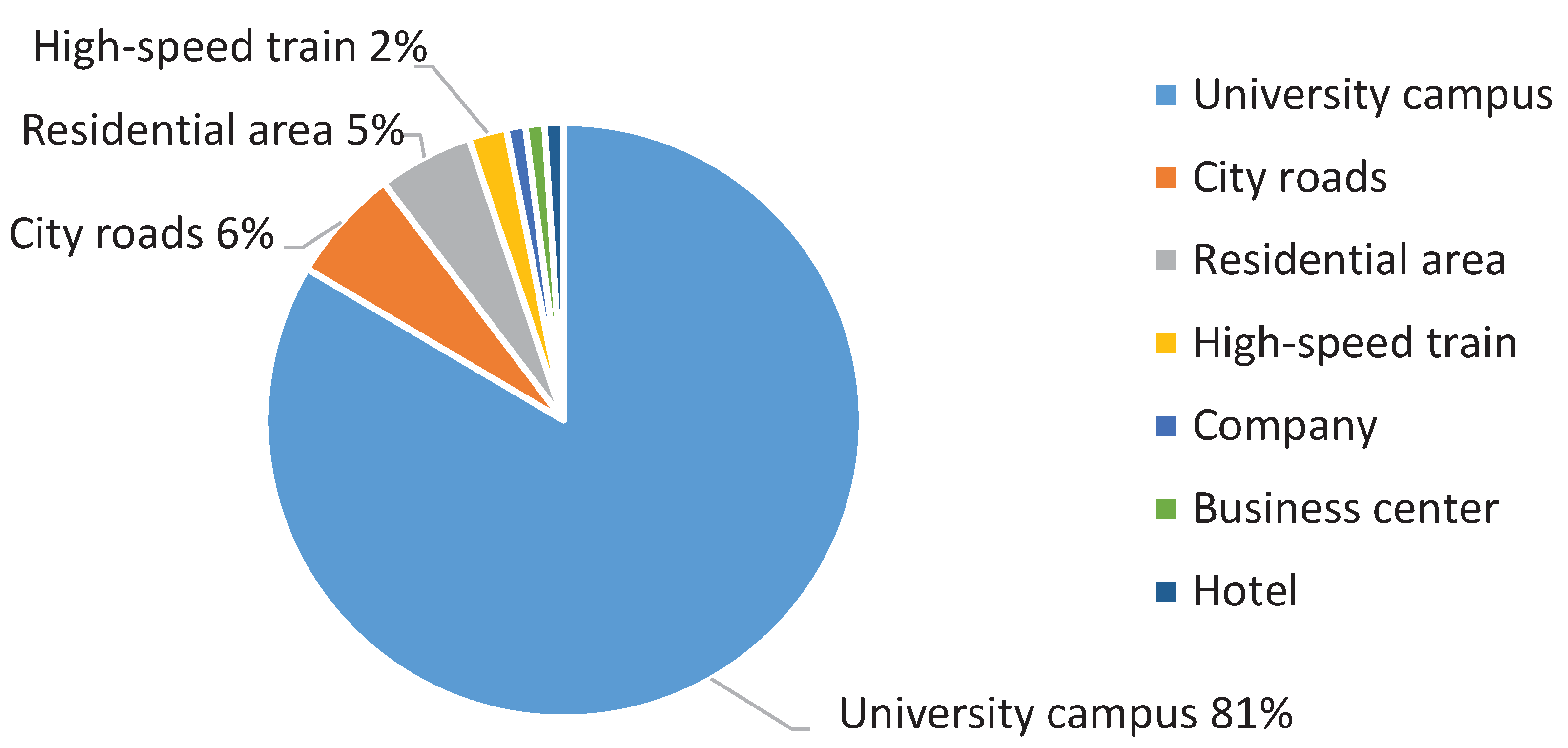

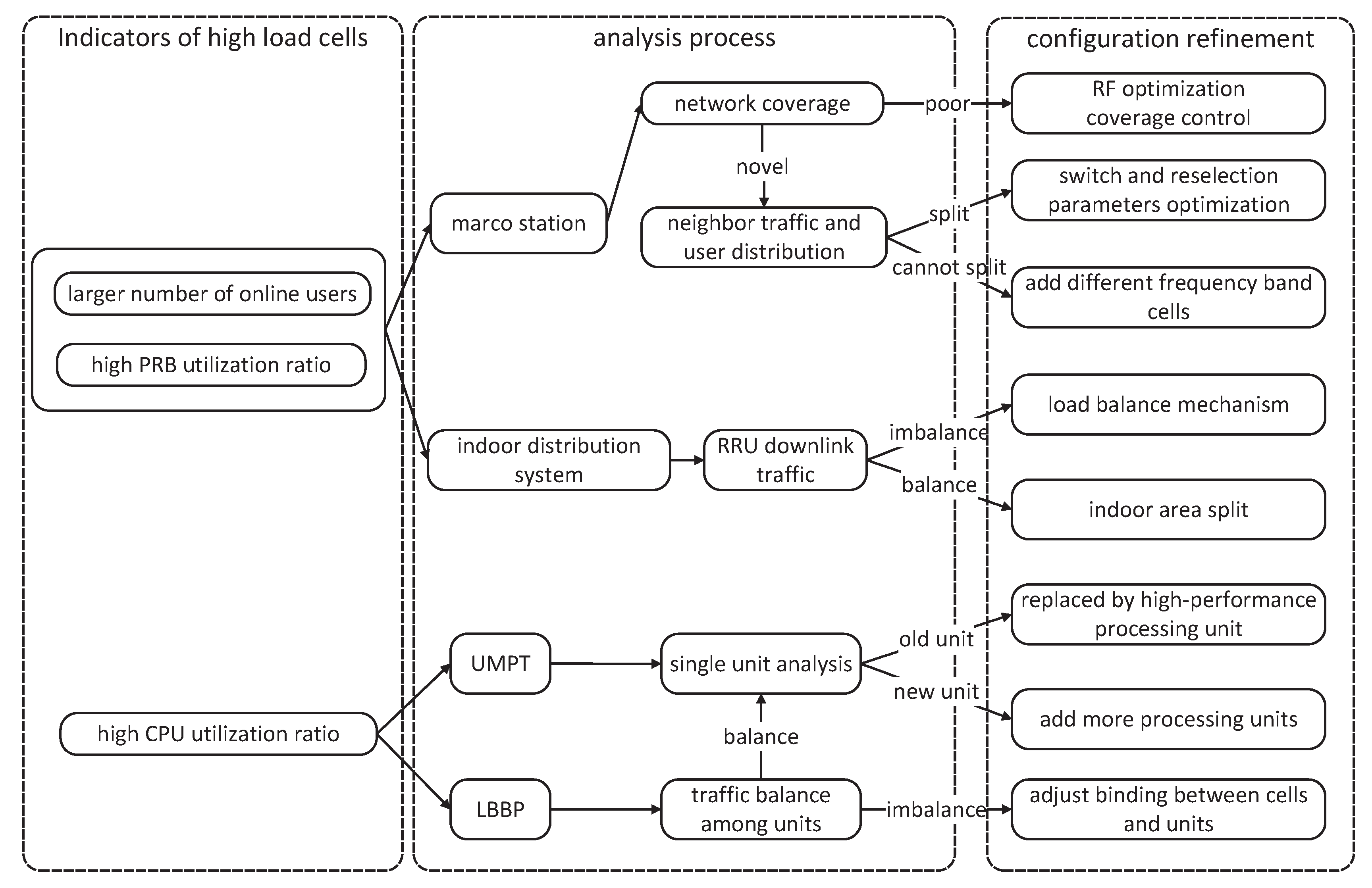
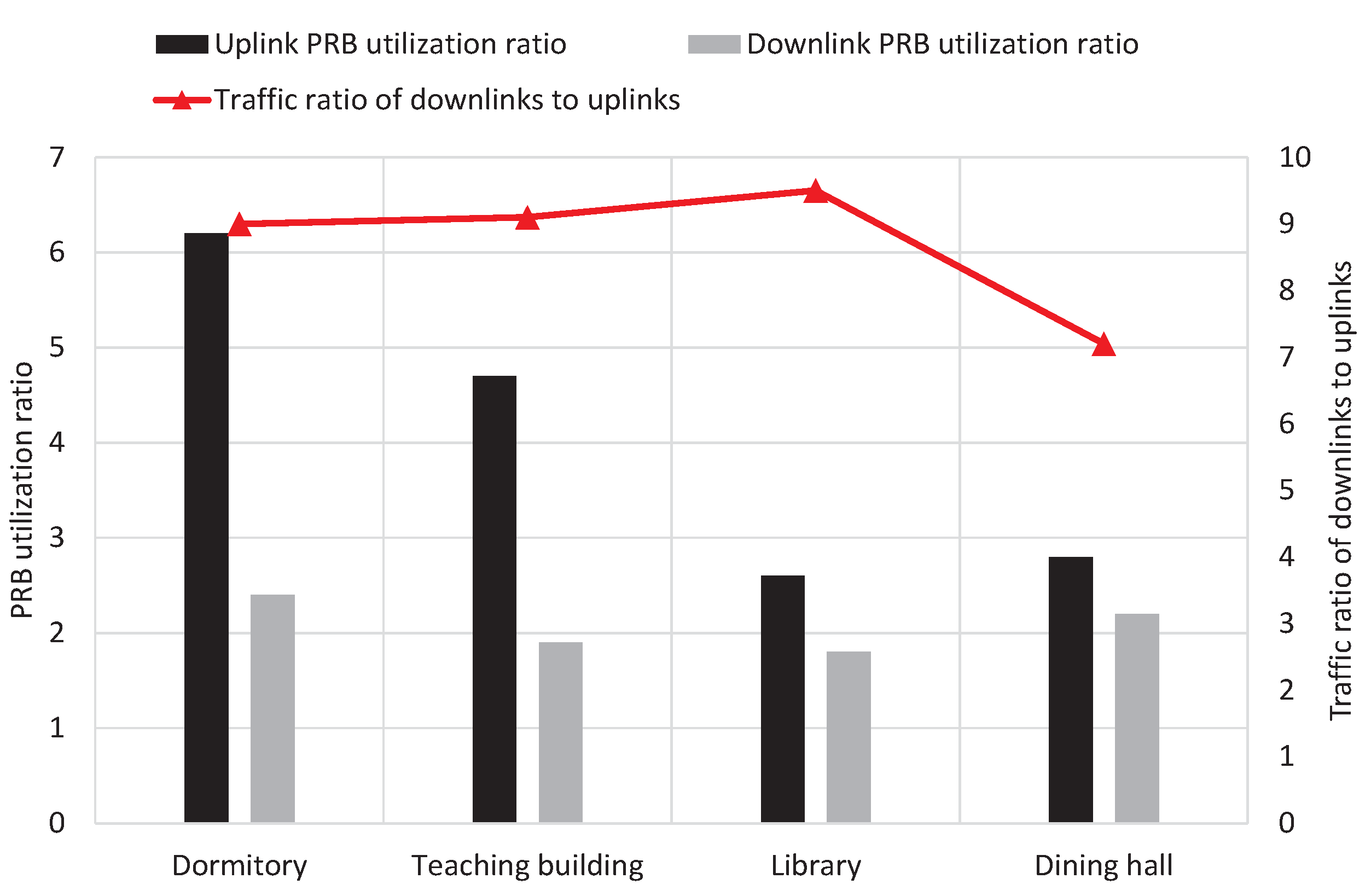
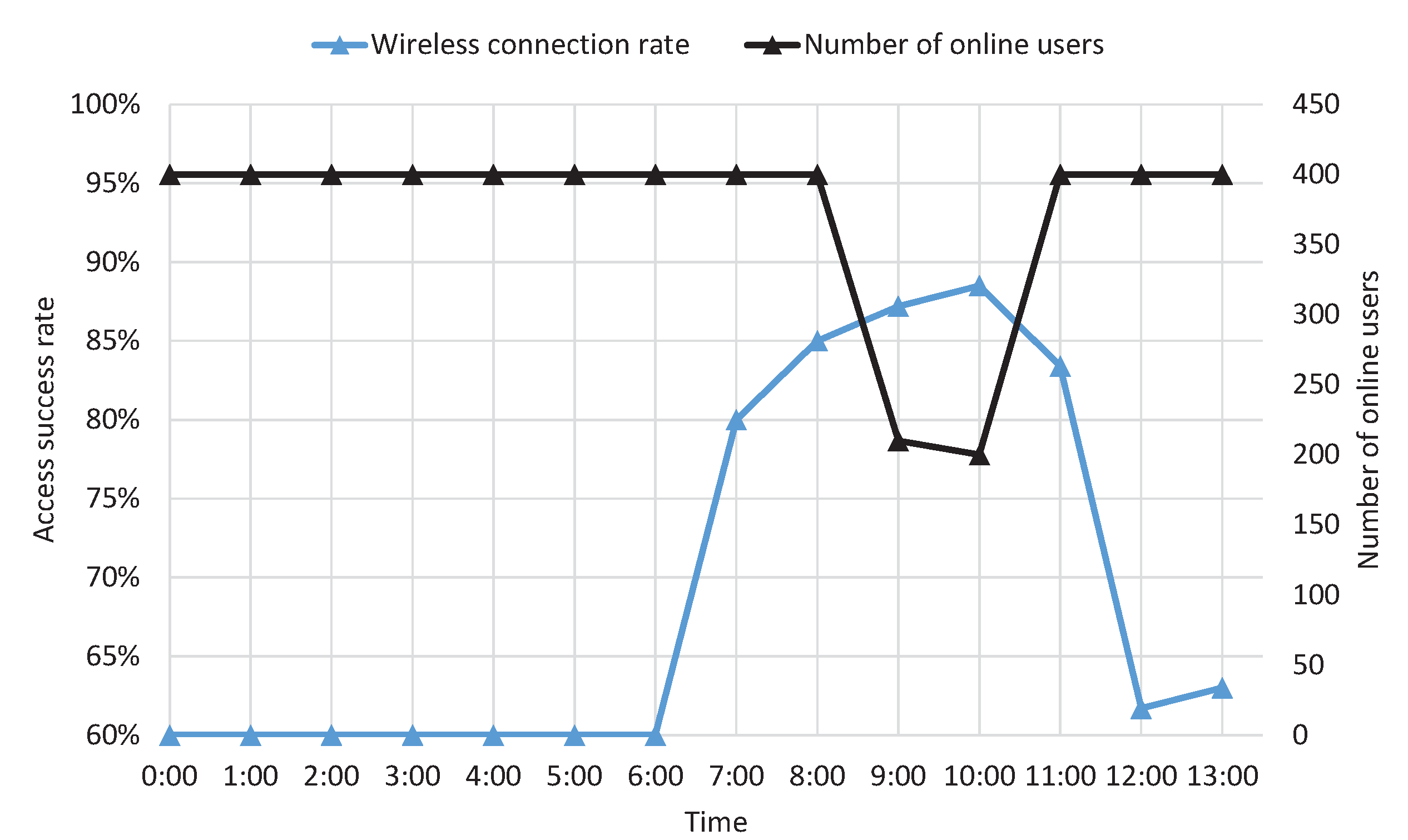

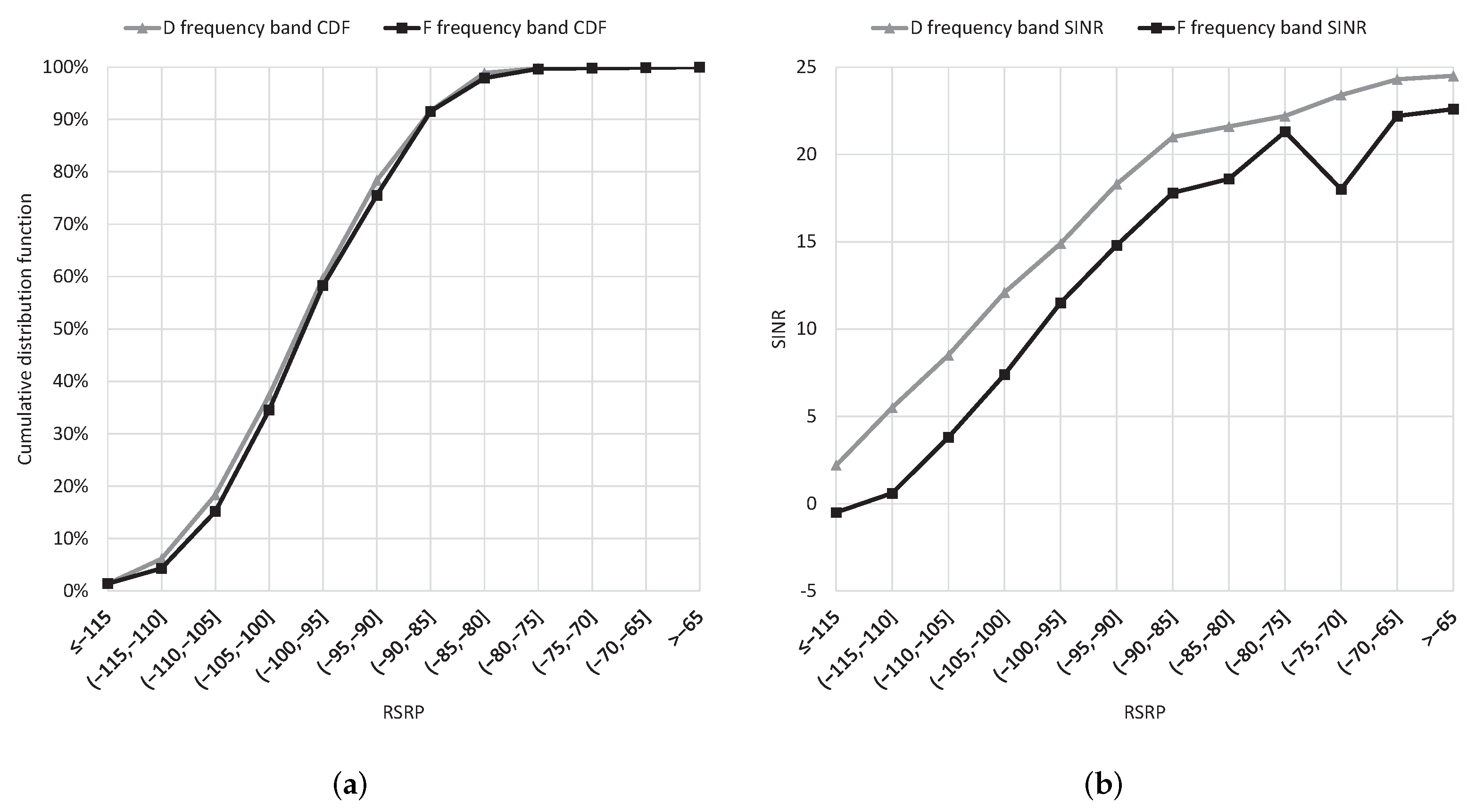

| Huawei | ZTE | Ericsson | DTT | Bell | |
|---|---|---|---|---|---|
| MNOU | >300 | >180 | |||
| PRB utilization ratio (or ANOU) | ANOU > 50, downlink PRB utilization ratio > 70%, downlink traffic > 2 GB, or uplink PRB utilization ratio > 500 MB | ||||
| Loads of UMPT and LBBP | LBBP CPU utilization ratio > 80% or UMPT CPU utilization ratio > 65% | UMPT CPU utilization ratio > 80% | UMPT CPU utilization > 60% | LBBP or UMPT CPU utilization ratio > 85% | UMPT CPU utilization ratio > 85% or other module utilization ratio > 90% |
| All cells | High Traffic Load Cells | |
|---|---|---|
| Access success rate | 98% | 90% |
| Single user data rate (Mbps) | 8 | 1 |
| RRC Setup Success Rate | MNOU | Unsuccess Times of PUCCH Allocation |
|---|---|---|
| 99.90% | 356 | 0 |
| 45.30% | 402 | 10,161 |
| 30.90% | 399 | 10,850 |
| Maximum CPU Utilization Ratio | RRC Setup Success Rate | Number of Dropped Messages | Maximum CPU Utilization Ratio | RRC Setup Success Rate | Number of Dropped Messages |
|---|---|---|---|---|---|
| LBBP | UMPT | ||||
| 72% | 99.4% | 0 | 67% | 100.0% | 0 |
| 84% | 83.7% | 4429 | 71% | 86.5% | 192 |
| 85% | 82.2% | 4730 | 71% | 75.4% | 1161 |
| 86% | 81.5% | 4819 | 72% | 70.2% | 1230 |
| ANOU and Downlink PRB Utilization Ratio | Percentage of Users (Downlink Data Rate Lower than 3 Mbps) |
|---|---|
| 50, 40∼50% | 1.75% |
| 50, 50∼60% | 17.83% |
| 50, 60∼70% | 41.30% |
| 50, 70∼80% | 72.99% |
| 50, 80∼100% | 88.24% |
| Bell | Huawei | |||
|---|---|---|---|---|
| Downlink PRB Utilization Ratio | Average Uplink PRB Utilization Ratio | Average Downlink PRB Utilization Ratio | Average Uplink PRB Utilization Ratio | Average Downlink PRB Utilization Ratio |
| 0∼10% | 2% | 1% | 8% | 2% |
| 10∼15% | 16% | 12% | 34% | 12% |
| 15∼20% | 21% | 17% | 31% | 18% |
| 20∼30% | 25% | 23% | 34% | 23% |
| ≥30% | 30% | 32% | 40% | 42% |
| Reselection | Parameters | Configuration |
|---|---|---|
| ThreshXHigh | ThreshXHigh = ThreshServLow + 4 dB | |
| ThreshServLow | According to the distribution of RSRP If the percentage of , the percentage of the number of users in cells with D frequency band = N, then ThreshServLow | |
| ThreshXLow | ThreshXLow = QRxLevMin |
| Huawei | ZTE | Bell | Ericsson | DTT | |
|---|---|---|---|---|---|
| Time slot ratio of uplink to downlink | 1:3 | ||||
| SR/CQI | setup user access first | ‘SRTrCHNum’ ‘CQIRptTTINum’ | N/A | ||
| Double networking reselection | : the priority of user reselection in D band is higher than that of F band; ThreshServLow setting: based on RSRP distribution of D cellular networks | ||||
| Double networking load balance | Enable , | ||||
| Scenario | Large-Scale Ceremony Event | Concert | Scenic Spots in Holidays | Transport Hubs in Holidays | |||
|---|---|---|---|---|---|---|---|
| The Youth Olympic Games | Provincial Sport Games | Concert A | Concert B | Garden A in National Day | Garden B in Halloween | Railway Station in National Day | |
| Uplink traffic (MB) | 3625 | 1731 | 859.2 | 2853.25 | 394.4 | 1002.5 | 506.22 |
| Downlink traffic (MB) | 3573 | 3703 | 1852.6 | 4985.82 | 1991 | 4139 | 6825.23 |
| Traffic ratio of uplink to Downlink | 0.98 | 2.14 | 2.15 | 1.75 | 5.05 | 4.13 | 13.46 |
| Time Slot Ratio of Uplink to Downlink = 1:3 | ||
| Traffic ratio of uplink to downlink | Uplink PRB utilization ratio | Downlink PRB utilization ratio |
| 0.88% | 33% | 4% |
| 1.75% | 48.32% | 13.84% |
| Time Slot Ratio of Uplink to Downlink = 2:2 | ||
| Traffic ratio of uplink to downlink | Uplink PRB utilization ratio | Downlink PRB utilization ratio |
| 1.62% | 7.44% | 3.3% |
| 2.14% | 5.12% | 5.98% |
| Scenario | Large-Scale Ceremony Event | Concert | Scenic Spots in Holidays | Transport Hubs in Holidays | |||
|---|---|---|---|---|---|---|---|
| The Youth Olympic Games | Provincial Sport Games | Concert A | Concert B | Garden A in National Day | Garden B in Halloween | Railway Station in National Day | |
| Number of RRC attempts per user | 108.5 | 93.89 | 88.7 | 105.6 | 80.57 | 107.5 | 70.38 |
| Traffic load of each RRC attempt (kB) | 61.06 | 66.66 | 76.89 | 32.44 | 75.23 | 275.8 | 127.74 |
| Parameters | Function | Preferred Value |
|---|---|---|
| Control format indicator (CFI) | Guarantee the resource of physical downlink control channel (PDCCH) | 3 |
| UE inactivated timer | Increasing UE inactivated timer can reduce the number of establishing RRCs; decrease UE inactivated timer can reduce the number of online users during a certain period | 10 |
| Access class barring (ACB) factor | Decreasing the value of the ACB factor can reduce the number of attempts to establish RRC during a certain period | 0.95 |
| Average RSRP (dBm) | Average SINR (dB) | Downlink Data Rate (Mbps) | |
|---|---|---|---|
| strategy 1 | −93.19 | 11.42 | 21.34 |
| strategy 2 | −96.94 | 15.06 | 24.33 |
| Parameters | Public Network | Private Network (High-Speed Railway) |
|---|---|---|
| defaultpagingcycle | 1280 ms | 320 ms |
| tReselectionIntraEUTRA | 2 s | 0 s |
Publisher’s Note: MDPI stays neutral with regard to jurisdictional claims in published maps and institutional affiliations. |
© 2022 by the authors. Licensee MDPI, Basel, Switzerland. This article is an open access article distributed under the terms and conditions of the Creative Commons Attribution (CC BY) license (https://creativecommons.org/licenses/by/4.0/).
Share and Cite
Su, R.; Zhang, M.; Ding, F.; Hu, G.; Qi, Q. Scenario-Based Configuration Refinement for High-Load Cellular Networks: An Operator View. Appl. Sci. 2022, 12, 1483. https://doi.org/10.3390/app12031483
Su R, Zhang M, Ding F, Hu G, Qi Q. Scenario-Based Configuration Refinement for High-Load Cellular Networks: An Operator View. Applied Sciences. 2022; 12(3):1483. https://doi.org/10.3390/app12031483
Chicago/Turabian StyleSu, Ruoyu, Meinan Zhang, Fei Ding, Guilong Hu, and Qi Qi. 2022. "Scenario-Based Configuration Refinement for High-Load Cellular Networks: An Operator View" Applied Sciences 12, no. 3: 1483. https://doi.org/10.3390/app12031483






